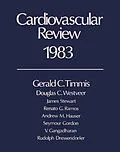Cardiovascular Review 1983 is an attempt to assimilate most of the clinically germane English-speaking cardiologie literature in as concise and timely a format as possible. Thus, this textual compendium of individual reports represents as current a summary of cardiologic thinking as the publishing process will allow. With 1625 references having been added to the 1982 edition, bringing the total to almost 7000, the Review constitutes not only as ready and comprehensive an updated reference as is probably available, but also a bibliographic resource. The table of contents has been constructed to reflect the order in which the preponderance of cardiologic literature appears. Thus, ischemic heart disease, valvular heart disease, arrhythmias, and conduction defects have been assigned a high priority reflected by their location in the first few sections of this book. Thereafter, topics ranging from acromegaly to tumors of the heart have been addressed in alphabetical order.
Inhalt
Preface to Fourth (1983) Edition
Preface to First (1979) Edition
Preface to Second (1980) Edition
Preface to Third (1982) Edition
Ischemic Heart Disease
I. Natural History
Angina
Myocardial Infarction
Aneurysm
The Changing Mortality of Coronary Heart Disease
Progression of Coronary Atherosclerosis
Regression
II. Epidemiology and Risk Factors
Age, Sex, and Genetics
Alcohol
Blood Pressure
Coffee
Contraceptives and Endogenous Endocrine Influences
Diabetes Mellitus
Hematocrit
Lipids
Obesity
Physical Fitness
Psychosocial Risks
Radiation
Retiring
Risk Intervention
Smoking
Trace Metals and Minerals (including Water Hardness)
Uric Acid
III. Clinical Aspects of Ischemic Heart Disease
Angina
Arrhythmias and Conduction Defects
Asymptomatic or Unrecognized Ischemia and Myocardial Infarction
Bezold-Jarisch Reflex
Diabetes
Extension vs Expansion of Myocardial Infarction
Fever
Heart Size
Hypertension
Hyperventilation
Hypoxemia
Humoral Control
Ischemic Cardiomyopathy
Left Main Coronary (LMC) Disease and "Left Main Equivalent" (LME)
Pericarditis
Peripheral Vascular Disease
Prehospital Course
Premonitory Symptoms (Prodrome) of an Acute Coronary Event
Prognosis and Survival
Pulmonary Edema
Pulmonary Function
Pulse
Renal Disease
Retinal Changes as an Indicator of Coronary Heart Disease
Rupture
Sex
Shock
Site of Infarction and Its Significance
Sudden Death and Prehospital Cardiac Arrest
Thromboembolism
Valsalva Maneuver
Ventricular Aneurysm and Thrombosis
Young People with Coronary Heart Disease
IV. Pathogenesis, Pathophysiology, and Pathology
Alcohol
Anomalies of Coronary Arteries
Aortic Regurgitation
Arteriovenous Fistula
Atherogenesis
Atrial Involvement
Collaterals
Complement
Coxsackie Virus
Drugs and Coronary Heart Disease
Metabolism of Ischemia
Myocardial Bridging
Myocardial Oxygen Supply and Demand
Nephrotic Syndrome
Pathologic Anatomy and Its Significance
Physiology of Coronary Heart Disease (Hemodynamics)
Radiation
Thromboembolism, Platelets, Prostaglandins, and Vasospastics Mechanisms
Ventricular Function
V. Diagnosis
History
Physical Examination
Bayes' Theorem. The Effect of Pretest Likelihood of Disease on the Utility of Diagnostic Tests
The Electrocardiogram at Rest
Ambulatory Monitoring (Dynamic Electrocardiogram; DCG)
Transtelephonic Monitoring
Exercise (Stress) Electrocardiography
The Chemistry of Ischemia
Scintigraphy (Radioisotopic Imaging)
Echocardiography
Fluoroscopy
Systolic Time Intervals
Sizing of Infarction
Cardiac Catheterization (Hemodynamic, Cardiodynamic, and Coronary Arteriographic Studies)
VI. Therapy
Changing Patterns of Therapy
Medical Management
Special Therapeutic Situations
Surgery
Valvular Heart Disease
I. Etiology and Incidence
II. Clinical
Aortic Stenosis (AS)
Aortic Regurgitation (AR)
Mitral Stenosis (MS)
Mitral Regurgitation (MR)
Mitral Annular Calcification
Mitral Valve Prolapse (MVP; Click Syndrome)
Tricuspid Valve Prolapse (Multiple Floppy Valves)
Tricuspid Stenosis (TS) and Regurgitation (TR)
Embolic Complications
The Myocardial Impairment and Hypertrophy of Valvular Disease
Diagnosis
Prognosis
III. Therapy of Valvular Heart Disease
Medical
Pacing
Surgery
Arrhythmias and Conduction Defects
I. Cardiac Rhythm in Healthy Populations
II. Supraventricular Arrhythmias
Paroxysmal Supraventricular Tachycardia (PSVT)
Atrial Flutter
Atrial Fibrillation (AF)
Atrial Dissociation
Atrial Asystole
Chaotic Atrial Mechanisms
Junctional Mechanisms
Hemodynamics of Atrioventricular Dissociation
III. Ventricular Arrhythmias
Etiology and Mechanisms
Risk and Natural History
Site, Significance, and Prognosis
Associate Conduction Defects
Ventricular Tachycardia (VT)
Ventricular Fibrillation (VF)
IV. Diagnosis
Electrocardiogram
Ambulatory Recordings
Exercise Testing
Electrophysiology Studies
Echocardiogram
V. Long Q-T Syndromes (LQTS) and Torsade de Pointes
Criteria
Etiology and Pathophysiology
Clinical
Pathology
Treatment
Results and Prognosis
VI. Conduction
Classification
Atrial
Atrioventricular Block (AVB)
His-Purkinje Conduction, Bundle Branch, and Fascicular Block
Accelerated Conduction [Wolff-Parkinson-White (WPW), Lown-Ganong-Levine (LGL), and Concealed Accessory Pathways]
Conduction as Affected by Electrolytes
VII. Sick Sinus Syndrome (including Carotid Sinus Syncope)
Etiology and Pathology
Clinical Characteristics
Associated Arrhythmias and Conduction Defects
Drug Effects
Diagnosis
Risk and Prognosis
VIII. Treatment of Arrhythmias and Conduction Defects
Indications for Treatment
General Principles
Results of Treatment
Antiarrhythmic Agents
Pacemaker Therapy
Neuromechanical Maneuvers
Atrial Ventricular Ablation by Catheter Techniques
Surgery
Acromegaly
Aging
Alcohol
Amyloidosis
Anemia (including Sickle Cell Anemia)
Aneurysms and Dissections of Great Vessels
Anorexia Nervosa
Arteritis
Athletic Heart
Bartter's Syndrome
Behcet's Syndrome
Carcinoid
Cardiomyopathy
I. Hypertrophic Cardiomyopathy (HCM)
Etiology
Pathology
Ventricular Function and Hemodynamics
Mechanism of Obstruction
Cavity Obliteration
Mechanism of Systolic Anterior Mitral Motion (SAM) and Mitral Prolapse
Apical Hypertrophy
Symptoms and Clinical Course
Arrhythmias and Conduction Defects
Hypertrophic Cardiomyopathy in Childhood
Natur…
